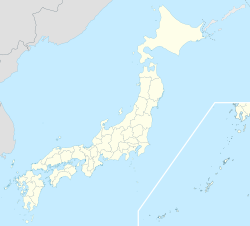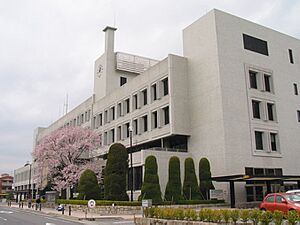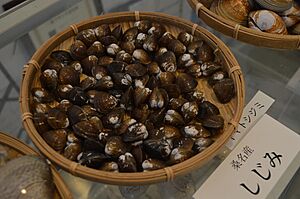Kuwana, Mie facts for kids
Quick facts for kids
Kuwana
桑名市
|
|||||||||||
|---|---|---|---|---|---|---|---|---|---|---|---|
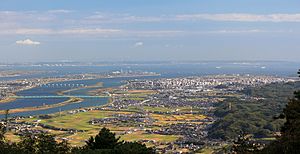
Kiso Three Rivers and Ise Bay from Mount Tado
|
|||||||||||
|
|||||||||||
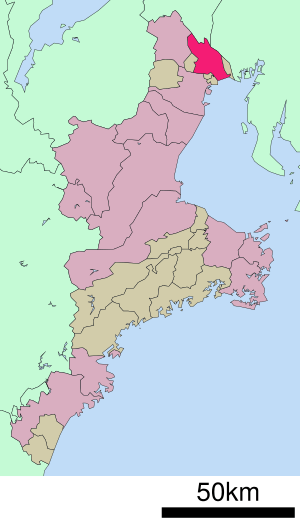
Location of Kuwana in Mie Prefecture
|
|||||||||||
| Country | Japan | ||||||||||
| Region | Kansai | ||||||||||
| Prefecture | Mie | ||||||||||
| Area | |||||||||||
| • Total | 136.68 km2 (52.77 sq mi) | ||||||||||
| Population
(March 31, 2021)
|
|||||||||||
| • Total | 141,045 | ||||||||||
| • Density | 1,031.94/km2 (2,672.70/sq mi) | ||||||||||
| Time zone | UTC+9 (Japan Standard Time) | ||||||||||
| Phone number | 0594-24-1136 | ||||||||||
| Address | 2-37 Chūōchō, Kuwana-shi, Mie-ken 511-8601 | ||||||||||
| Climate | Cfa | ||||||||||
|
|||||||||||
Kuwana (桑名市, Kuwana-shi) is a city located in Mie Prefecture, Japan. As of March 31, 2021, the city was home to about 141,045 people. These people live in 60,301 households. The city covers an area of about 136.68 square kilometers.
Contents
Geography of Kuwana
Kuwana is in the northern part of Mie Prefecture, facing the Pacific Ocean. It sits where the Kiso Three Rivers meet the sea. These rivers separate Mie and Aichi Prefectures. Because of its location, Kuwana has always been an important place for fishing, factories, businesses, and culture.
Nearby Cities and Towns
Kuwana shares borders with several other cities and towns:
- In Aichi Prefecture: Aisai and Yatomi
- In Gifu Prefecture: Kaizu
- In Mie Prefecture: Asahi, Inabe, Kawagoe, Kisosaki, Tōin, and Yokkaichi
Kuwana's Climate
Kuwana has a Humid subtropical climate. This means it has warm summers and cool winters. There is usually little to no snow. The average temperature in Kuwana is about 16.1 degrees Celsius. The city gets about 1616.3 millimeters of rain each year. September is usually the wettest month.
The hottest month is August, with an average temperature of about 28.0 degrees Celsius. January is the coldest month, with an average of about 4.8 degrees Celsius.
| Climate data for Kuwana (1991−2020 normals, extremes 1979−present) | |||||||||||||
|---|---|---|---|---|---|---|---|---|---|---|---|---|---|
| Month | Jan | Feb | Mar | Apr | May | Jun | Jul | Aug | Sep | Oct | Nov | Dec | Year |
| Record high °C (°F) | 17.7 (63.9) |
20.6 (69.1) |
24.9 (76.8) |
30.8 (87.4) |
34.1 (93.4) |
37.5 (99.5) |
39.7 (103.5) |
40.4 (104.7) |
38.0 (100.4) |
32.3 (90.1) |
26.3 (79.3) |
21.9 (71.4) |
40.4 (104.7) |
| Mean daily maximum °C (°F) | 9.2 (48.6) |
10.2 (50.4) |
13.9 (57.0) |
19.3 (66.7) |
24.0 (75.2) |
27.1 (80.8) |
31.0 (87.8) |
32.7 (90.9) |
29.0 (84.2) |
23.3 (73.9) |
17.3 (63.1) |
11.6 (52.9) |
20.7 (69.3) |
| Daily mean °C (°F) | 4.8 (40.6) |
5.5 (41.9) |
8.9 (48.0) |
14.2 (57.6) |
19.1 (66.4) |
22.8 (73.0) |
26.7 (80.1) |
28.0 (82.4) |
24.4 (75.9) |
18.6 (65.5) |
12.6 (54.7) |
7.3 (45.1) |
16.1 (60.9) |
| Mean daily minimum °C (°F) | 1.2 (34.2) |
1.5 (34.7) |
4.5 (40.1) |
9.6 (49.3) |
14.8 (58.6) |
19.3 (66.7) |
23.5 (74.3) |
24.6 (76.3) |
20.9 (69.6) |
14.8 (58.6) |
8.6 (47.5) |
3.5 (38.3) |
12.2 (54.0) |
| Record low °C (°F) | −5.3 (22.5) |
−6.4 (20.5) |
−4.4 (24.1) |
0.2 (32.4) |
6.0 (42.8) |
11.6 (52.9) |
16.3 (61.3) |
15.5 (59.9) |
10.9 (51.6) |
4.5 (40.1) |
−0.7 (30.7) |
−5.0 (23.0) |
−6.4 (20.5) |
| Average precipitation mm (inches) | 54.3 (2.14) |
63.2 (2.49) |
112.8 (4.44) |
141.7 (5.58) |
166.8 (6.57) |
209.5 (8.25) |
193.2 (7.61) |
137.1 (5.40) |
233.3 (9.19) |
165.8 (6.53) |
79.7 (3.14) |
59.0 (2.32) |
1,616.3 (63.63) |
| Average precipitation days (≥ 1.0 mm) | 6.3 | 7.1 | 9.2 | 9.3 | 10.2 | 12.3 | 11.8 | 8.7 | 11.1 | 9.3 | 6.4 | 7.1 | 108.8 |
| Mean monthly sunshine hours | 159.8 | 158.3 | 188.5 | 194.3 | 199.9 | 154.2 | 175.2 | 218.6 | 163.3 | 167.1 | 157.8 | 156.7 | 2,093.6 |
| Source: Japan Meteorological Agency | |||||||||||||
Kuwana's Population Growth
The number of people living in Kuwana has grown steadily over the last 60 years. This information comes from Japanese census data.
| Historical population | ||
|---|---|---|
| Year | Pop. | ±% |
| 1950 | 78,754 | — |
| 1960 | 88,556 | +12.4% |
| 1970 | 101,403 | +14.5% |
| 1980 | 110,310 | +8.8% |
| 1990 | 124,042 | +12.4% |
| 2000 | 134,856 | +8.7% |
| 2010 | 140,281 | +4.0% |
History of Kuwana
Long ago, during the Heian period and Muromachi period, the area of Kuwana was a very important seaport. It was called Juraku-no-tsu. Merchants controlled the port. A poet named Socho wrote in 1515 that it was a big city with over a thousand houses, temples, and inns.
Later, during the Sengoku period (a time of wars), a powerful leader named Oda Nobunaga took control. After Nobunaga died, another strong leader, Toyotomi Hideyoshi, took over.
Under the Tokugawa shogunate, Kuwana became a castle town for the Kuwana Domain. It was also the 42nd post station on the important Tōkaidō highway. This road connected Edo (now Tokyo) with Kyoto. Many travelers would take boats across Ise Bay to Kuwana. This made the journey more fun. Since the boat trip took a whole day, Kuwana was a necessary stop. This helped the city's inns and restaurants, which were famous for fresh seafood, especially clams.
During World War II, in July 1945, Kuwana was badly damaged by air raids. About 90% of the city was destroyed. In 1959, a big storm called the Isewan Typhoon also caused a lot of damage.
On December 6, 2004, the towns of Nagashima and Tado joined with Kuwana.
Kuwana's Economy
Kuwana is well-known for its metal casting industry. This industry is still very important to the local economy. They make things like manhole covers and gratings. Another traditional industry is making Banko ware ceramics. Woodworking, including wooden trays and furniture, is also important.
Commercial fishing, especially farming hamaguri clams, is a big industry too. Today, many people who work in nearby Nagoya and Yokkaichi live in Kuwana. There is a large housing area called Ōyamada west of the city center.
Education in Kuwana
Kuwana has many schools for kids. The city government runs 27 public elementary schools and nine public middle schools. The Mie Prefectural Department of Education runs four public high schools. There is also one private elementary school, middle school, and high school. For students with special needs, the prefecture also has one special education school.
Transportation in Kuwana
Railway Lines
Several train lines connect Kuwana to other places:
 JR Tōkai – Kansai Main Line
JR Tōkai – Kansai Main Line
- Nagashima - Kuwana
 Kintetsu Railway – Nagoya Line
Kintetsu Railway – Nagoya Line
- Kintetsu Nagashima - Kuwana
 Yōrō Railway – Yōrō Line
Yōrō Railway – Yōrō Line
- Kuwana - Harima - Shimo-Fukaya - Shimo-Noshiro - Tado
 Sangi Railway – Hokusei Line
Sangi Railway – Hokusei Line
- Nishi-Kuwana - Umamichi - Nishibessho - Rengeji - Ariyoshi - Hoshikawa - Nanawa
Major Highways
Important roads that pass through or near Kuwana include:
 Higashi-Meihan Expressway
Higashi-Meihan Expressway Isewangan Expressway
Isewangan Expressway National Route 1
National Route 1 National Route 23
National Route 23 National Route 258
National Route 258 National Route 421
National Route 421
Local Attractions and Fun Things to Do
Kuwana has many interesting places to visit and fun festivals.
Places to Visit
- Kiso Sansen National Government Park
- Mount Tado
- Nabana no Sato, famous for its amazing lights and decorations.
- Nagashima Spa Land, a popular amusement park.
- Rokkaen, a beautiful historic house and garden.
- Tado Shrine, an important local shrine.
Festivals to Enjoy
- Ishidori Matsuri
- Tado Festival, held every May.
Famous Local Foods
Sister Cities
Kuwana has special connections with other cities, called "sister cities":
 Tomamae, Hokkaidō, since September 1981
Tomamae, Hokkaidō, since September 1981 Gyōda, Saitama, since November 9, 1998
Gyōda, Saitama, since November 9, 1998 Shirakawa, Fukushima, since November 9, 1998
Shirakawa, Fukushima, since November 9, 1998
Notable People from Kuwana
Many talented people come from Kuwana, including:
- Toyama Atsuko, a government official and diplomat.
- Hirooki Goto, a professional wrestler.
- Koji Iwamoto, a professional wrestler.
- Mikako Komatsu, a voice actress.
- Tsugio Matsuda, a racing driver.
- Tatsumi Naofumi, a samurai and general in the Imperial Japanese Army.
- Toshihiko Seko, a long-distance runner.
- Katsuyori Shibata, a professional wrestler.
- Hiroki Shimowada, a voice actor.
Images for kids
See also
 In Spanish: Kuwana (Mie) para niños
In Spanish: Kuwana (Mie) para niños




